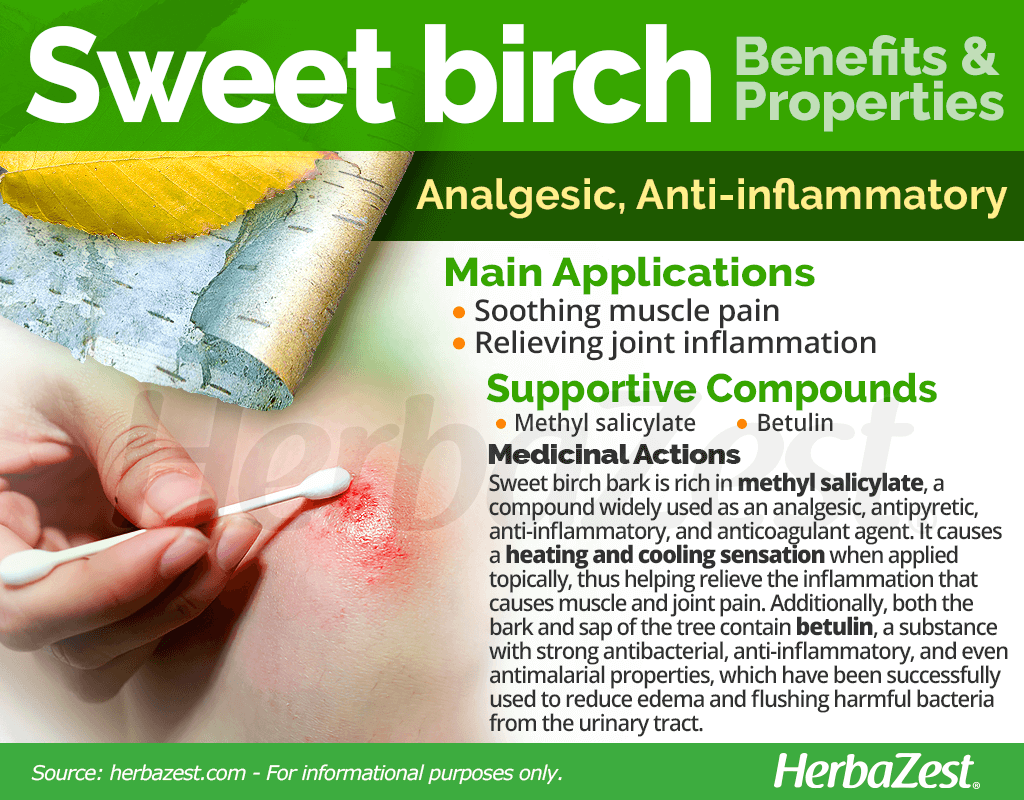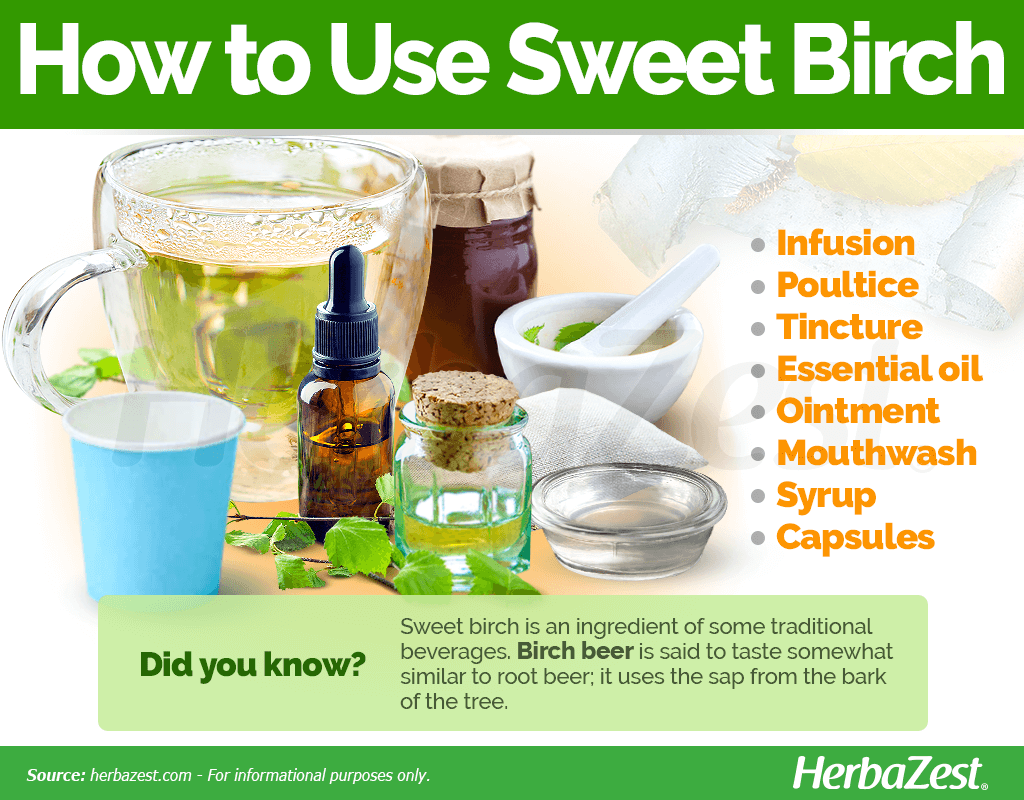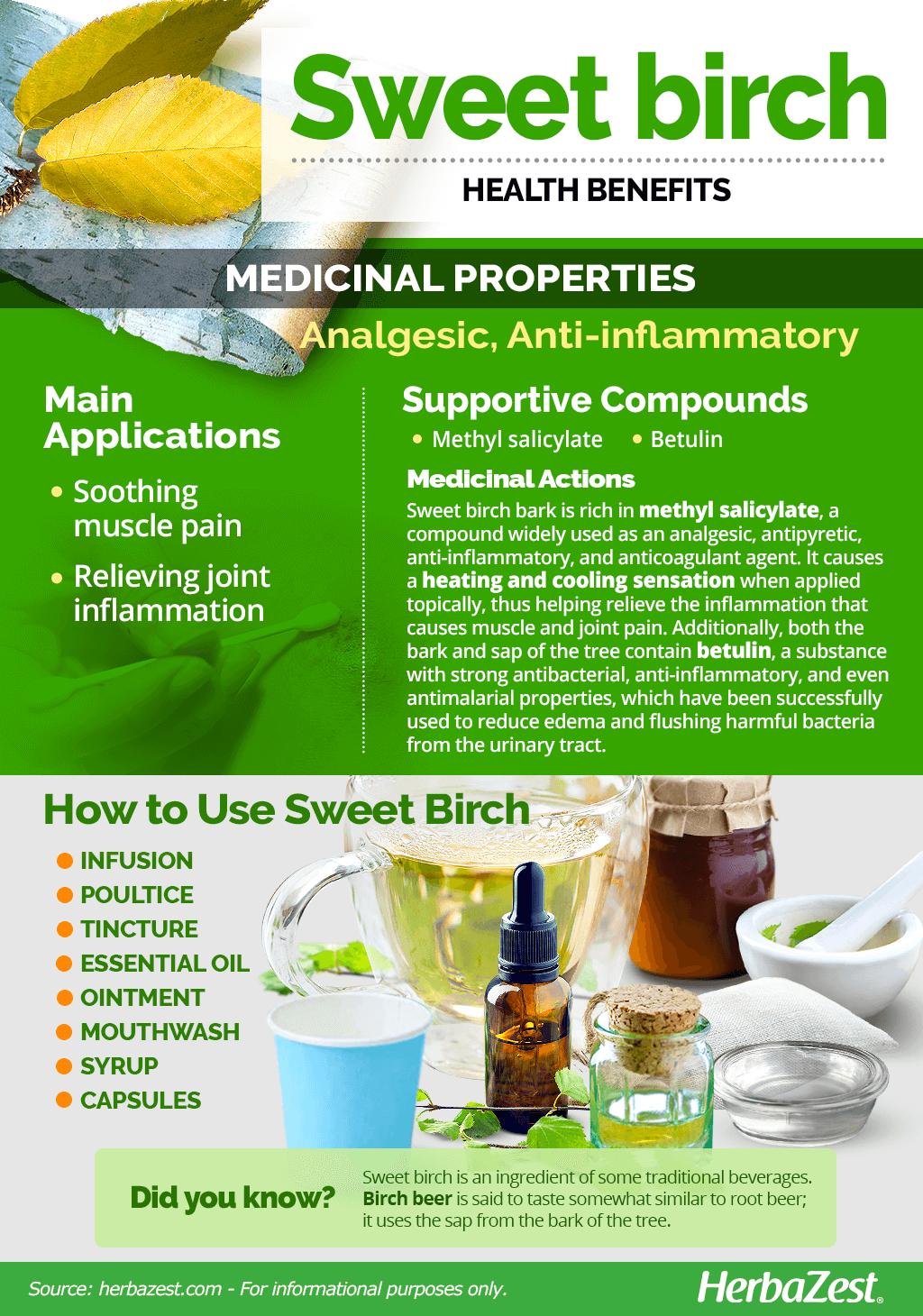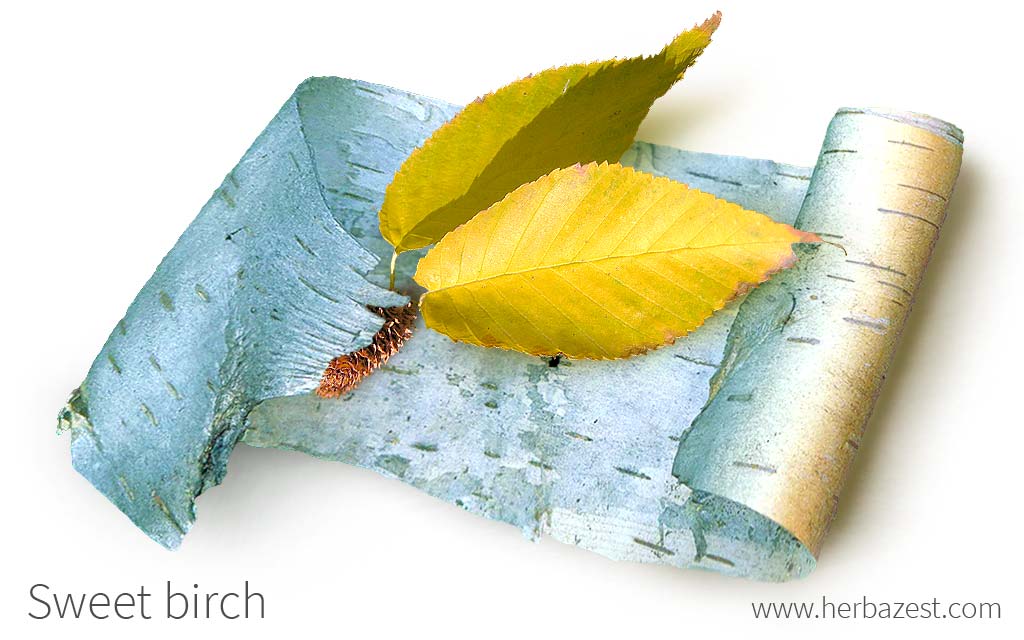Sweet birch is a grand, commanding tree that can be found across North America - particularly in the east - and has been especially revered by Native Americans as an herbal remedy for a variety of ailments. Today, concoctions made with sweet birch remain trusted by herbalists for treating some specific health conditions.
Sweet Birch Medicinal Properties
- Medicinal action Analgesic, Anti-inflammatory
- Key constituents Methyl salicylate, betulin
- Ways to use Capsules, Hot infusions/tisanes, Tincture, Poultice, Ointment, Essential oil
- Medicinal rating (2) Minorly useful plant
- Safety ranking Use with caution
Health Benefits of Sweet Birch
The sweet birch tree has long been popular for its use in the treatment of different ailments, particularly among Native Americans and many herbalists, who still prescribe it as a natural treatment for several conditions. Scientific research has corroborated some of sweet birch's medicinal applications, which include:
Soothing muscle pain. Compounds found in the bark of the tree are known to help relieve muscular pain, and its essential oil is frequently used in lotions and creams.
Relieving joint inflammation. Lotions made with sweet birch bark can be used to relieve pain and inflammation caused by rheumatoid arthritis.
Additional sweet birch benefits include:
Detoxifyng the urinary system. The tea made of sweet birch bark has been prescribed for cleansing the kidneys and the liver.
Treating fluid retention. The mild diuretic ability of sweet birch can be useful to those who suffer from swelling caused by fluid retention, encouraging regular urination.
Sweet birch has also been recommended for remedying burns, dandruff, dysentery, and the common cold, among other health conditions. Nowadays, these traditional applications are less common due to the availability of many other natural and commercial medicines.
How It Works
Possibly the most significant constituent found in the sweet birch tree is methyl salicylate, which is a colorless, yellowish, or reddish liquid present in the bark that is widely used as an analgesic, antipyretic, anti-inflammatory, and anticoagulant agent. It causes a heating and cooling sensation when applied topically, thus helping relieve muscle and joint pain.1,2
Another major substance contained in sweet birch is betulin, which can be found in the bark and sap of many species of birch, and it is known to have antibacterial, anti-inflammatory, and even antimalarial properties. In scientific studies, betulin extract has proven as effective as indometacin, a non-steroidal anti-inflammatory drug used to reduce edema.3 Its action against bacteria is believed to be the reason why birch leaf tea can act as an effective cleanser for the urinary tract.
Birch tree leaves are rich in protein, fatty acids, carbohydrates, and fiber, all of which are necessary to keep a well-functioning immune system.
Other herbs that sooth muscle pain are ginger and peppermint, while cat's claw and nettle are great for reducing joint pain and inflammation. Additionally, angelica and parsley, can help help flush body toxins by promoting urination.
Sweet Birch Side Effects
If taken in recommended doses, sweet birch is considered safe for ingestion and external use; however, it contains methyl salicylate, which can be toxic in high concentrations. Some research suggests that doses below 70 mg/lb (150 mg/kg) are safe. Overconsumption of sweet birch may cause undesirable effects, such as headache, dizziness, confusion, drowsiness, sweating, thirst, and nausea.
Sweet Birch Cautions
It is important to follow the instructions supplied with creams and lotions, because methyl salicylate is easily absorbed by the skin. Lower concentrations can be toxic to children, and so it is recommended that minors under the age of 12 do not consume sweet birch at all.
It is particularly important to avoid sweet birch during pregnancy and lactation. Likewise, people scheduled for surgery, as well as those who suffer from any serious conditions, should speak with their doctor before taking sweet birch or any other herbal supplement.

How to Consume Sweet Birch
- Edible parts Inner bark, Leaves, Sap, Oil
- Edible uses Flavoring, Beverage
- Taste Aromatic, Sweet
It is possible to consume the plant in a number of different forms to benefit from its medicinal properties. Sweet birch is more often consumed in the form of herbal remedies. Having said this, sweet birch is also used in traditional food and beverage recipes.
Birch leaves appear in some recipes for borscht, a traditional Ukrainian soup found all over Eastern Europe. They are cooked in with the other ingredient and are said to bring a mild, sweet taste to the dish.
Natural Forms
Infusion. A sweet birch infusion is made by steeping the leaves - and sometimes the buds or fruits - in hot water. This preparation is usually taken to clean the urinary system and as a diuretic.
Poultice. A poultice can be made from the leaves and sap of the plant. This can be applied topically on aching joint and muscles also.
Herbal Remedies & Supplements
Tincture. This preparation is obtained by covering the crushed components of the plant with alcohol. It can be used externally, or diluted with water in medicinal doses for drinking.
Capsules. These are a less common form, but they can be convenient for those who wish to take sweet birch as a dietary supplement for its various medicinal properties.
Essential oil. This can be extracted from the bark and sap. The essential oil contains 97 - 99% methyl salicylate; therefore, it is extremely important not to exceed the recommended dosage. It is for topical use only. A medical expert should be consulted for proper dilution guidelines before the oil is applied.
Ointment. The essential oil is used to prepare a salve for the topical treatment of muscular - and sometimes joint - pain. The sensation of temperature change that it causes can be helpful in relieving soreness.
Mouthwash. Native Americans used a solution of sweet birch bark to gargle as a breath freshener and to support oral hygiene.
- Syrup. The sap of the tree can also be extracted and boiled down to make a syrup.

Growing
- Life cycle Perennial
- Harvested parts Leaves, Bark
- Light requirements Partial shade
- Soil Well-drained
- Soil pH 5.1 – 5.5 (Strongly acidic), 5.6 – 6.0 (Moderately acidic), 6.1 – 6.5 (Slightly acidic)
- Growing habitat Temperate climates, Humid regions
- Planting time Early spring
- Plant spacing average 7 m (22.97 ft)
- Potential insect pests Aphids, Beetles
- Potential diseases Nectria cankers
- Potential animal pests Birds, Chipmunks, Squirrels
The sweet birch is a tall and attractive tree that grows in temperate regions all over the world. A healthy specimen should survive for at least 40 - 50 years, but without proper care, birch trees have been known to die before they reach the age of 20. Even after they are well-established, it is important to administer proper care in order to keep them in good health.
Growing Guidelines
The ideal location is one in which the ground is shaded throughout much of the day, but the area above receives full sun - the birch leaves grow best if they have access to sun for around six hours per day.
Sweet birch trees require cool, moist soil. The optimum soil type is slightly acidic - with a pH of 5.0 - 6.5.
Birch trees have a surprisingly shallow root system, which can be easily disturbed if set in firm soil. For this reason, they should not be planted in or near areas that could become compacted, like paths or driveways.
The plant needs generous and frequent irrigation in order to grow well. Depending on weather conditions, in the summer it is recommended to supply it with 8 - 18 inches (20 - 25 cm) of water once a week.
Some pests, such as aphids and beetles; and diseases, like canker, are known to affect birch trees. Early detection is crucial, as they can spread rapidly.
Additional Information
- Other uses Furniture/carpentry, Repellent
Plant Biology
Sweet birch is a large, deciduous tree that can reach heights of 40 - 50 feet (12 - 15 m) in its maturity. It has alternative leaves that are two to six inches (5 - 15 cm) long and oval; these are of a medium green color in the summer, and turn to yellow before falling in autumn. When the tree is in flower, elongated green cones will develop at the end of the branches. These become soft to touch and dry out at the end of the blooming season.
Classification
Sweet birch (Betula lenta) belongs to the genus Betula, which is one of six genera comprising the Betulaceae family, which includes over 234 species; over half of these are in the genus Betula.
Species Related to Sweet Birch
Some of the more noteworthy species in the Betula genus include B. pendula, or silver birch, and B. pubescens, or downy birch. Like B. lenta, these have had many historical medicinal uses and boast similar properties, such as anti-inflammatory and analgesic actions.
Historical Information
The name "birch" is derived from the Old English word beohrt, which means shiny or bright, and the common name "sweet birch" relates to the traditional Native American method of using the sap of the tree to make syrup or sugar.
Back in time, in the Appalachian mountains where they are abundant, young sweet birch trees were cut and chopped into chips. Great amounts were milled to obtain a single quart of oil, which was then sold to apothecaries to be transformed into a variety of medicinal preparations.
During the American Civil War, due to the amount of nutrients contained in the bark of sweet birch, it was eaten by the troops as a supplement. According to Ben Charles Harris (Compleat Herbal, 1972), hundreds of Confederate soldiers owed their lives to the consumption of the bark, and their route could be easily traced by the peeled trunks of birch trees.
Popular Beliefs
In Scandinavia, birch trees were believed to ward off evil spirits and witchcraft. In Europe, birch has a long history of use as a tonic, and it is believed to make hair thicker and healthier; however, this traditional use has not been backed by any scientific studies.
Other Uses
Furniture. Birch trees, including sweet birch, are widely used for making furniture. When the wood is exposed, it becomes darker over time, and develops a color similar to mahogany. It is a strong material and can withstand different external conditions, such as humidity.
Beverages. Sweet birch is an ingredient of some traditional beverages. Birch beer is said to taste somewhat similar to root beer; it uses the sap from the bark of the tree.
- Insecticide. Another alternative use for the tree is as an insecticide. The oil extracted from the bark is an effective protective agent that helps preserve furniture and fur.
The sweet birch tree is a useful source of medicinal properties; however, due to the recent rise of alternative herbal therapies and modern remedies widely available nowadays, its popularity has dwindled. Today, it is usually grown as an ornamental, suited to recreational grounds and wooded areas.
Sources
- A Natural History of Trees of Eastern and Central North America, p. 174
- Icelandic Herbs and Their Medicinal Uses
- Pharmacology & Pharmacy, Biological Activity of Betulinic Acid: A Review, 2012
- Plants For A Future, Betula lenta
- Purdue University, Betula lenta L.
- Rodale's Illustrated Encyclopedia of Herbs
- The Earthwise Herbal: A Complete Guide to Old World Medicinal Plants, p. 140
- The Morton Arboretum, Sweet birch
- The Plant List, Betula
- Toxnet Toxicology Data Network, Methyl Salicylate
- United States Department of Agriculture, How to Grow and Maintain a Healthy Birch Tree
- University of Kentucky, Sweet birch
- Backyard Medicine, pp. 13 - 15
- Journal of Ethnopharmacology, Medicinal plants of the genus Betula—Traditional uses and a phytochemical–pharmacological review, 2015
- U.S. National Park Service Plant Guides, Sweet Birch
Footnotes:
- Clinical Therapeutics. (2010). Efficacy and safety profile of a topical methyl salicylate and menthol patch in adult patients with mild to moderate muscle strain: a randomized, double-blind, parallel-group, placebo-controlled, multicenter study. Retrieved January 23, 2024, from: https://pubmed.ncbi.nlm.nih.gov/20171409/
- Frontiers in Phamacology. (2022). Safety and efficacy of compound methyl salicylate liniment for topical pain: A multicenter real-world study in China. Retrieved January 23, 2024, from: https://www.ncbi.nlm.nih.gov/pmc/articles/PMC9634125/
- Plants (Basel). (2021). Anti-Inflammatory and Anticancer Properties of Birch Bark-Derived Betulin: Recent Developments. Retrieved January 23, 2024, from: https://www.ncbi.nlm.nih.gov/pmc/articles/PMC8705846/





